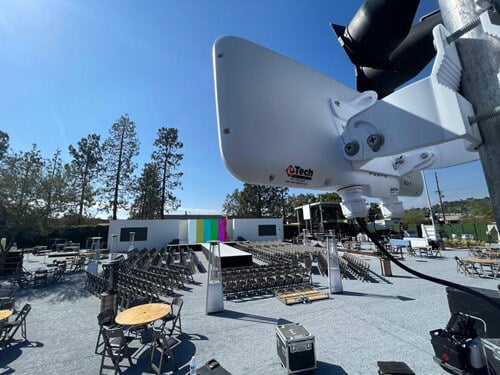Could Channel Bonding Be the Internet Solution You Need?
There are very few things that can get under just about everyone’s skin quite like an unreliable internet connection.
Whether you are at home trying to relax and stream some Netflix, or even worse, preparing for a big work call, presentation, or demo in which a reliable connection is a must, it can be stress-inducing to say the least when you don’t have one.
Outside of purchasing the fastest available internet speeds for your home or office (or event), what other options do you have to ensure you can get connected?
Perhaps, channel bonding is the answer to your internet woes.

What is Channel Bonding?
In simple terms, the process of uniting two weaker internet “lines” into a single, stronger line. We like to imagine it as a zipper where you can merge one sort of internet connection (like Wi-Fi) with another (ethernet or cable, for example). When the two are “zipped up” together, they offer a connection that is more dependable and has the added advantage of having more connections and bandwidth. This can be done by combining DSL connections and Hotspots, Wi-Fi and LTE from a phone, cable and DSL, and other combinations.
The ability to mix any sort of internet with one another is one of the most appealing features of internet bonding. It is not required that there be two different types of internet. Instead, Wi-Fi bonding is possible with practically any internet connection type. It covers Wi-Fi, DSL, ethernet, cable, and other technologies. In other words, if you know that your event will only be powered by Wi-Fi, you can combine two Wi-Fi connections to create a single, stronger connection.
You’re not alone if you haven’t heard of channel bonding. Channel bonding may also go by the names of the following when used to improve your home Wi-Fi and internet connection: WiFi bonding, internet bonding, broadband bonding, etc.

What Does Channel Bonding Provide?
Speed – One of the main advantages of channel bonding is to solve the problem of slow internet. A single broadband connection may have problems and be slow depending on outside factors like the weather and technical difficulties. An internet bonding device, on the other hand, will combine many internet connections to provide high-speed connectivity. Because of this, even if one connection fails, the remaining connections will still function to maintain constant internet connectivity. Therefore, time loss caused by unneeded buffering can be avoided with the use of bonding internet connections.
Speed isn’t everything for event planning or business internet, but it comes close. Users expect speed since it influences everything: download times, how quickly videos play, the ease with which they can use complicated event software, and more. When the internet is slow, it may be annoying at best and completely boring at worst. Your speed can be significantly increased via internet bonding by a factor of roughly 50%.
Fast internet enables your presentations to run smoothly (which may include breakout sessions, social spaces, gamification of your content, and more). Multitasking without any problems, watching videos, and downloading stuff with ease.

Reliability – The dependability of the internet connection is also a big plus. People simply expect reliable, powerful internet access at the end of the day, especially during significant and essential events. If there is an excessive amount of traffic or if the weather is poor, one internet connection could go down. A bonded channel connection, on the other hand, combines the strength of multiple networks to create a single, dependable internet connection. As a result, even if one network is down, the others will continue to function to maintain a strong connection.
Bandwidth – Channel bonding benefits from higher bandwidth in addition to increased speed. This indicates that the internet connection you have is robust enough to support multiple devices connecting to the event’s Wi-Fi network. For instance, if you’re organizing a festival and you anticipate that hundreds of devices will be connecting to the event Wi-Fi at any given time, you’ll need a lot of bandwidth. As a result, there won’t be any noticeable lag when content is downloaded or streamed across those various devices.
Portability – Internet access is no longer limited to the home and business. These days, good internet connectivity is also necessary outdoors for events. Channel bonding devices can be useful in this situation. Bonding tools are designed to be small and portable so they may be used anywhere. When it comes to on-field internet requirements and broadcasting for outdoor events, these portable devices are a flexible choice. Additionally, quick setup and integration reduce the amount of time needed to connect the device during events.
5G Hotspots – Having a 5G Hotspot is a great idea for events, because it provides a quick, reliable connection so you don’t have to rely on the internet that’s provided by the venue. The good news is, it’s also great for bonding because it can add to the speed you get and provides a great backup.
***Article originally appeared on eTech Rentals Blog***
